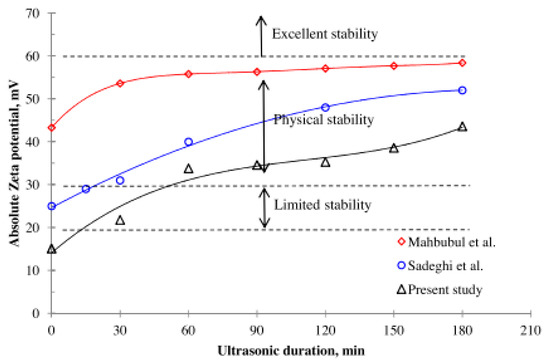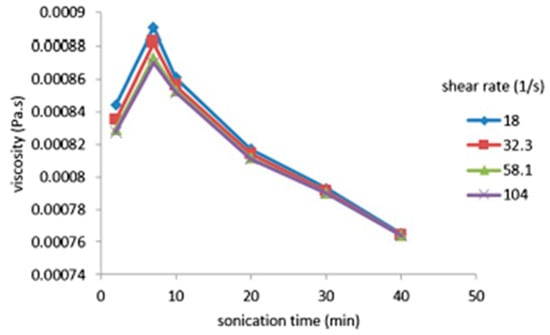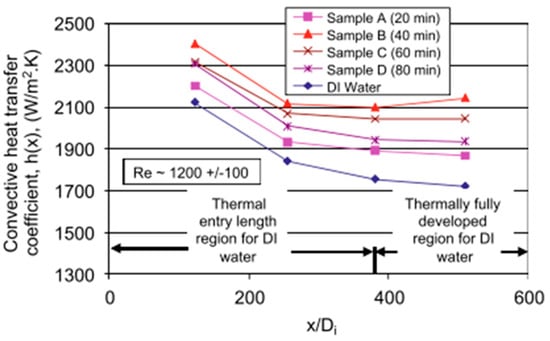Your browser does not fully support modern features. Please upgrade for a smoother experience.
Please note this is a comparison between Version 1 by Humaira Yasmin and Version 3 by Lindsay Dong.
The advent of nanotechnology has brought about significant technological advancements in many fields of study. The birth of nanofluids as an advanced thermal transport media in the area of thermal management is a laudable and notable feat. Nanofluids (mono and hybrid nanofluids) have been extensively researched and established to be better than conventional thermal transport media due to their enhanced thermophysical and convective properties.
- nanofluids
- preparation
- stability
- Mono and Hybrid Nanofluids
1. Preparation Techniques
Mono and hybrid nanofluids were prepared by suspending mono nanoparticles (MNPs) and hybrid nanoparticles (HNPs) in orthodox thermal fluids (Figure 13). The stability of these thermal fluids is of utmost importance as it significantly influences their thermal–optical–rheological properties and thermal performance in different applications. Generally, mono and hybrid nanofluids are formulated using one-step and two-step strategies. The two-step method involves two processes; first, the synthesis of MNPs or HNPs, and second, suspending of the MNPs or HNPs into the base fluids. The two-step strategy is the most used method published in the literature for the formulation of mono and hybrid nanofluids. This method can be engaged in large-scale production of mono and hybrid nanofluids suitable for industrial application with cost benefits. The flaw associated with this method involves the possibility of sedimentation and agglomeration of MNPs and HNPs owing to the Van der Waals forces of attraction among the particles [1][118].

Figure 13.
Representation of typical nanofluid preparation.
The one-step strategy involves simultaneous synthesis and suspension of MNPs and HNPs in the respective base fluids. This method is known to provide improved stability and homogeneity of mono and hybrid nanofluids, thereby eliminating arduous processes in comparison to the one-step strategy by reducing MNPs and HNPs clusters [1][2][118,119]. The industrial use of this method appears impracticable except for low vapor pressure fluids, and it is found to be expensive [3][120].
2. Stability
Suspending MNPs and HNPs in different base fluids induces charges leading to the formation of an electrical double layer (EDL) around the particle surface [4][123]. Thus, mono and hybrid nanofluids are said to be electrically conducting fluids. The imposition of a potential across these fluids causes oppositely charged electrodes to attract MNPs or HNPs and EDL. The formulation of EDL depends on the volume/weight fraction/concentration, size, and surface charge of the particles and the ion concentration in the base fluids. The application of mono and hybrid nanofluids strongly depends on the stability of these thermal fluids because their thermal–optical–rheological properties and thermal performance are linked to the concentration of MNPs or HNPs in the suspension [5][6][124,125]. Under the two-step strategy, the agglomeration and sedimentation of mono and hybrid nanofluids can be avoided, thereby improving the stability of the same by employing mechanical (sonication), surfactant addition, surface modification, and pH control techniques. Figure 24, Figure 35, Figure 46 and Figure 57 reveal the influence of viscosity, stability, thermal conductivity, and convective heat transfer performance, respectively, on sonication duration. In Figure 24, increasing sonication time is shown to enhance the stability (as measured using the zeta potential technique) of TiO2/water nanofluid. From Figure 35, the thermal conductivity of MWCNT/water nanofluid is noticed to enhance as temperature and sonication time increase. It is illustrated in Figure 46 that sonication time reduces nanofluid viscosity as the shear rate increases. In Figure 57, the peak convective heat transfer coefficient is achieved at the optimum sonication time under increasing flow development.

Figure 24.
Effect of ultrasonic duration on stability of TiO

Figure 35. Effects of ultrasonication time and temperature on thermal conductivity of nanofluids [8].

Figure 46. Variation in dynamic viscosity as function of sonication time at various shear rates at 45 °C [8].
Variation in dynamic viscosity as function of sonication time at various shear rates at 45 °C [126].

Figure 57. Influence of sonication duration on convective heat transfer coefficient (Re = 1200) of aqueous nanofluid. Adapted from [9].
Influence of sonication duration on convective heat transfer coefficient (Re = 1200) of aqueous nanofluid. Adapted from [127].
With the aid of ultrasonicators, numerous studies have reported the effect of sonication time, amplitude, modes, and probe tip width on the thermal conductivity, absorbance wavelength, viscosity, cluster size, surfactants, diameter of CNTs, and particle size [10][11][12][13][14][15][16][17][18][19][72,77,78,80,86,87,88,128,129,130]. It is reported that optimum sonication parameters lead to optimum stability conditions and other relevant measured parameters. These findings indicate the need to optimize sonication parameters in relation to other parameters to achieve improved stability. Nevertheless, this is not the case for most studies reported in the literature for mono and hybrid nanofluids, irrespective of the purpose of the experiments. Surfactants are chemical compounds used to improve the stability of mono and hybrid nanofluids by reducing the electrostatic repulsion and Van der Waals interaction between particles to evade the agglomeration of particles in the base fluid [20][131]. An increase in thermal conductivity, zeta potential, surface tension, and viscosity of mono and hybrid nanofluids under the utilization of different surfactants has been published in the literature [5][18][21][22][23][24][121,124,129,132,133,134]. In addition, the pH can be modulated to improve the stability of mono and hybrid nanofluids. The surface electric charges introduced due to the suspension of MNPs or HNPs into base fluids are altered to enhance the stability of mono and hybrid nanofluids. The farther the pH value from the isoelectric point (IEP), the greater the stability of the mono and hybrid nanofluids. Furthermore, the surface modification technique can be used to improve the stability of mono and hybrid nanofluids. It is worth noting that this technique is always surfactant-free with more improved stability [6][17][25][125,128,135]. The effect of surfactants on the thermal conductivity and thermal efficiency of mono and hybrid nanofluids is shown in Figure 68 and Figure 79, respectively. From Figure 68, variation in the thermal conductivity is observed for the 0.5 wt % MWCNT/DW nanofluid formulated using different surfactants and subjected to increasing temperature. Figure 79 shows that the thermal efficiency of a hybrid nanofluid varies with the type and concentration of surfactant used in the formulation. For all the hybrid nanofluids, the thermal efficiency increased as the Reynolds number rises.

Figure 68. Influence of different surfactants (GA, SDBS, and SDS) thermal conductivity of aqueous MWCNT nanofluids [8].
Influence of different surfactants (GA, SDBS, and SDS) thermal conductivity of aqueous MWCNT nanofluids [126].

Figure 79. Influence of surfactants (PVP and SDS) on thermal efficiency of hybrid nanofluids in a helical coil heat exchanger [26].
Influence of surfactants (PVP and SDS) on thermal efficiency of hybrid nanofluids in a helical coil heat exchanger [58].
For the characterization of mono and hybrid nanofluids, numerous techniques have been reported in the open literature. These include Raman spectroscopy, Fourier transform infrared spectroscopy, high-resolution transmission electron microscopy, X-ray diffractometer, scanning electron microscopy, vibrating sample magnetometer, transmission electron microscopy, light scattering, and energy-dispersive X-ray spectroscopy [11][27][28][29][30][31][32][33][1,77,136,137,138,139,140,141]. Scanning electron microscopy is the most reported technique for characterizing mono and hybrid nanofluids. To monitor the stability of mono and hybrid nanofluids, visual inspection, zeta potential, ultraviolet-visible (UV) spectrophotometer, and thermal property tracking (viscosity, thermal conductivity, turbidity, and density) methods are engaged [22][29][34][35][36][37][38][39][40][12,75,76,132,137,142,143,144,145].
